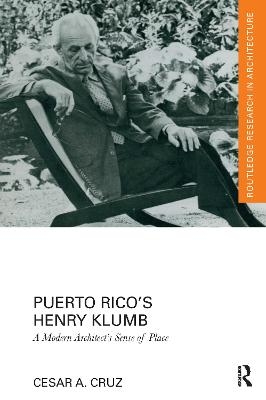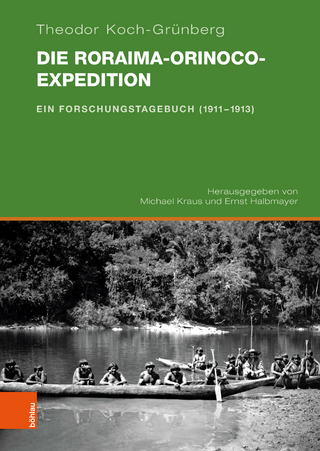
Puerto Rico’s Henry Klumb
Routledge (Verlag)
978-1-032-23742-8 (ISBN)
This book follows Henry Klumb’s life in architecture from Cologne, Germany to Puerto Rico. Arriving on the island, Klumb was a one-time German immigrant, a moderately successful designer, and previously a senior draftsman with Frank Lloyd Wright.
Over the next forty years Klumb would emerge as Puerto Rico’s most prolific, locally well-known, and celebrated modern architect. In addition to becoming a leading figure in Latin American modern architecture, Klumb also became one of Frank Lloyd Wright’s most accomplished protégés, and an architect with a highly attuned social and environmental consciousness. Cruz explores his life, works, and legacy through the lens of a sense of place, defined as the beliefs that people adopt, actions undertaken, and feelings developed towards specific locations and spaces. He argues that the architect’s sense of place was a defining quality of his life and work, most evident in the houses he designed and built in Puerto Rico.
Puerto Rico’s Henry Klumb offers a historical narrative, culminating in a series of architectural analyses focusing on four key design strategies employed in Klumb’s work: vernacular architecture, the grid and the landscape, dense urban spaces, and open air rooms. This book is aimed at researchers, academics, and postgraduate students interested in Latin American architecture, modernism, and architectural history.
Cesar A. Cruz is an architectural historian and educator. He has taught architectural history and theory, building structures, and design in Illinois, Indiana, and New Mexico. In August 2016 he received his Doctorate in Architecture from the University of Illinois in Urbana-Champaign.
List of Figures
Preface
Acknowledgements
Chapter 1 – Looking into a Modern Architect’s Sense of Place
A sense of place – a theoretical underpinning
Defining place
Places as sources of meaning, and other factors leading to a sense of place
Searching for evidence of phenomenological thinking
Investigative cycles and narrative writing
Chapter 2 – From Germany to the Modern American Metropolises, 1905 – 1927
Henry Klumb’s pamphlet series: an introduction
Klumb’s German period, 1905 – 1927: the setting that began to shape a young modern architect
Klumb, the early modernists, and higher values
Klumb and the (un)natural modern city, 1927 – 1929
Chapter 3 – With Wright in Arizona and Taliesin, 1929 – 1933
Camp Ocotillo
Taliesin
Chapter 4 – Vernacular Influences I: The Native American Projects, 1938 – 1941
Respecting tradition, nature, and context in Native American architecture
The Tulsa, Gallup, and San Francisco exhibits
Klumb in Sells, Arizona
Lasting impressions of the American Southwest and Klumb’s experiences there
Chapter 5 – Vernacular Influences II: Reimagining Puerto Rico’s Jibaro Hut, 1944 – 1948
Klumb’s Puerto Rico, February 1944
Puerto Rico’s post-war modernist project in context
The jibaro hut in Klumb’s pamphlets
The jibaro hut reimagined through the Teacher’s Farms
A return to the more traditional jibaro hut through the Low Cost Rural Houses
Chapter 6 – The Grid and the Landscape: The Haeussler Residence, 1945
Klumb’s orthogonal and triangular grids in Puerto Rico’s terrain
The Haeussler Residence
The Evans Residence
The Ewing, Fullana, Tugwell, and Foreman homes
The grid and the landscape within a series of oppositions
Chapter 7 – Open Air Rooms: The Emilio Rodriguez and Duchow Residences, 1951 and 1958
Klumb’s initial open air rooms in Puerto Rico – the patio
The varied moods of nature at Klumb’s terraces, verandas, cross-ventilated spaces, and breezeways
Chapter 8 – Additional House Types: Houses in Dense Urban Spaces and Modern Stilt Houses
Balancing nature with the burgeoning modern city
The Kogan House
The Marrero and Velez houses
Klumb’s modern stilt houses
The jibaro hut reimagined once more
A career in its twilight, 1967 - 1984
Chapter 9 – A Coda to a Sense of Place: The Klumb House, 1947 – 1984
Impressions of the Klumb House
An early personal transition for Klumb in Puerto Rico
Viewing the Klumb House through the architect’s naturalistic worldview
Chapter 10 – Conclusions
Appendix A – Klumb’s Pamphlet Series
Appendix B – Henry Klumb’s "Taliesin"
Appendix C – Notes on Klumb’s Houses
| Erscheinungsdatum | 14.12.2021 |
|---|---|
| Reihe/Serie | Routledge Research in Architecture |
| Verlagsort | London |
| Sprache | englisch |
| Maße | 156 x 234 mm |
| Gewicht | 453 g |
| Themenwelt | Sozialwissenschaften ► Ethnologie |
| Sozialwissenschaften ► Soziologie | |
| Technik ► Architektur | |
| ISBN-10 | 1-032-23742-2 / 1032237422 |
| ISBN-13 | 978-1-032-23742-8 / 9781032237428 |
| Zustand | Neuware |
| Haben Sie eine Frage zum Produkt? |
aus dem Bereich


